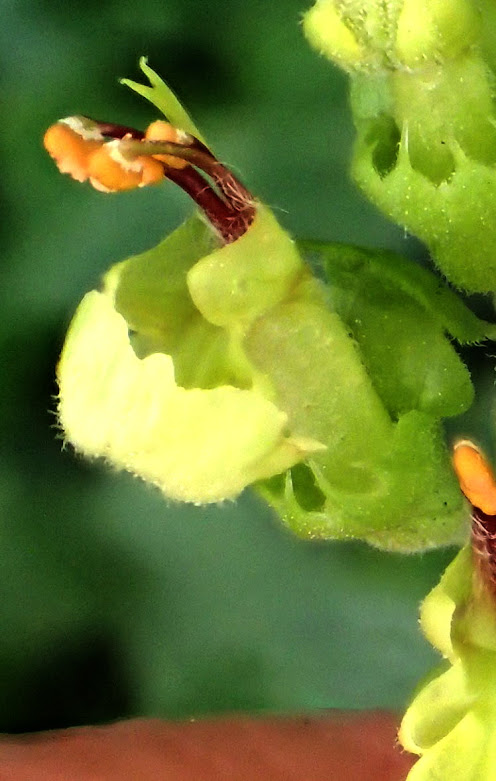Leaving reds at last (even though there are several more to do) and proceeding through the spectrum to .. orange:
Reds and yellows are available in abuncance but there is an amazing shortage of oranges. What can you think of? I have found 1. Wood Sage (-well the anthers are orange) and 2. Fox and Cubs
1. Wood Sage Teucrium scorodonia
This has a only a weak smell, in spite of its name.
A month ago 29 June as I was walking beyond Buckhaw Brow down the main road toward the bypass I looked at the flowers and they had amazing structure and orange anthers.
They have zygomorphic flowers (bilaterally symmetrical - a bit like orchids) and the fruit consists of four dry (very rarely fleshy), one-seeded nutlets
(Other members of this family already seen include the Woundworts (Stachys) and Selfheal (Prunella vulgaris) and Blue Bugle (Ajuga reptans)
The choice for the Twitter tag #Wildflowerhour this Sunday is #Deadnettlefamily - so they will have lots of pictures this week. If you can, post your pictures for #wildflowerhour this Sunday 2 Aug 8-9pm using #Deadnettlefamily. Happy flower-hunting!
-------------------------------------------
2. Fox and Cubs Pilosella aurantiaca
Most people have noticed this - it grows well in public places. It is now found wild but it came from central Europe
 |
| The road from Langcliffe down to Settle on 30 July.. |
 |
| The road from Langcliffe down to Settle on 30 July.. |
 |
| This last photo show the "Fox" and "cubs" well. |
The closeup pictures were taken on the footpath on The Mains, Giggleswick at the end of June.
There are flowers out now (end of July) in and near Giggleswick Churchyard and on the footpath at the main road near Langcliffe.
Here is a link to a good vimeo video of the plant opening
In the key (Stace) it says for Pilosella:
Stolons usually present; achenes less than 2 (or 2.5 mm) long, each rib ending in a small point at the apex of the achene,.
Whereas Hieracium and Crepis have no stolons and each rib ends in a ring at the apex of the achene.






No comments:
Post a Comment